check oil BMW M3 CONVERTIBLE 2008 E93 Owner's Manual
[x] Cancel search | Manufacturer: BMW, Model Year: 2008, Model line: M3 CONVERTIBLE, Model: BMW M3 CONVERTIBLE 2008 E93Pages: 172, PDF Size: 5.29 MB
Page 14 of 172
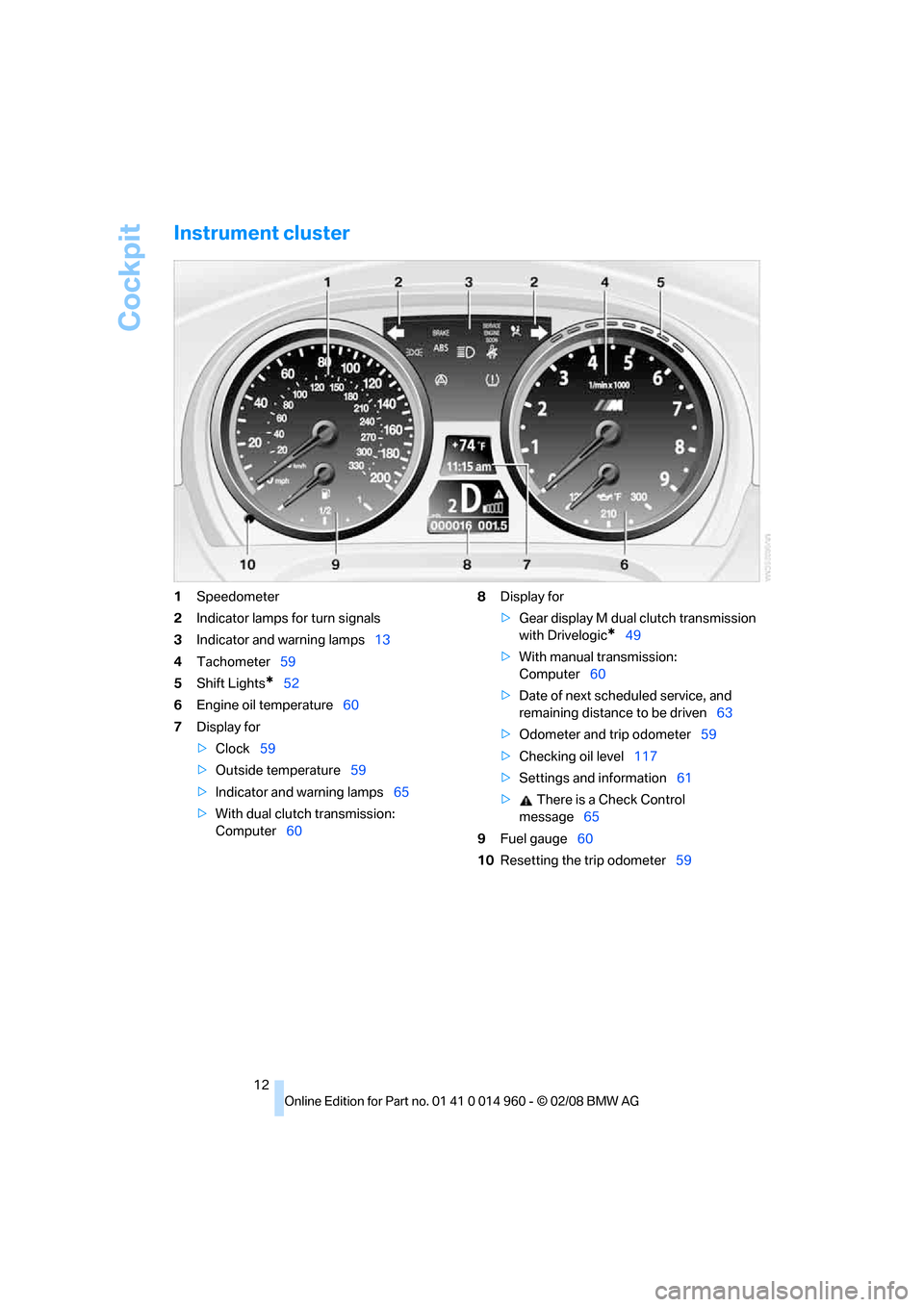
Cockpit
12
Instrument cluster
1Speedometer
2Indicator lamps for turn signals
3Indicator and warning lamps13
4Tachometer59
5Shift Lights
*52
6Engine oil temperature60
7Display for
>Clock59
>Outside temperature59
>Indicator and warning lamps65
>With dual clutch transmission:
Computer608Display for
>Gear display M dual clutch transmission
with Drivelogic
*49
>With manual transmission:
Computer60
>Date of next scheduled service, and
remaining distance to be driven63
>Odometer and trip odometer59
>Checking oil level117
>Settings and information61
> There is a Check Control
message65
9Fuel gauge60
10Resetting the trip odometer59
Page 62 of 172
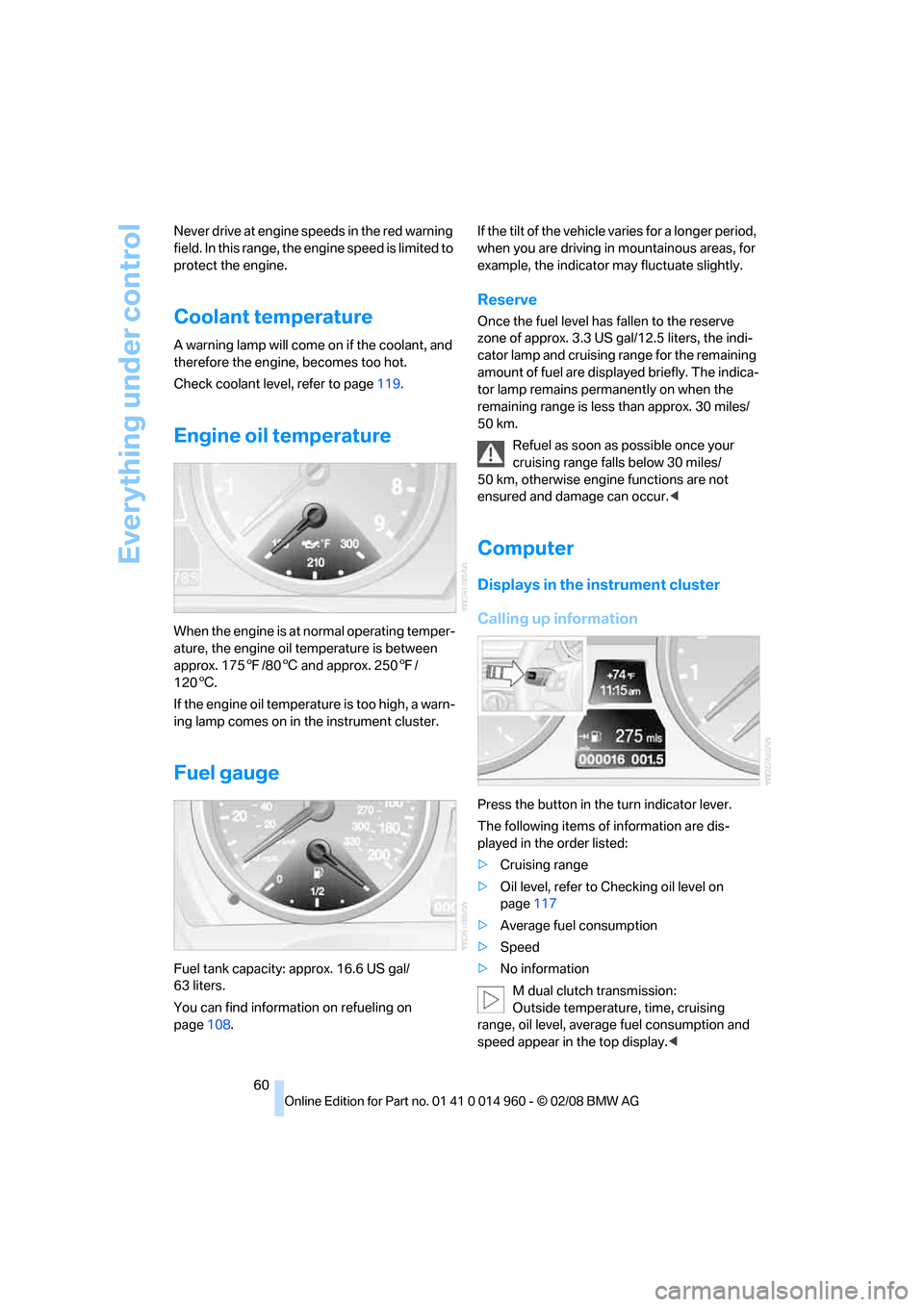
Everything under control
60 Never drive at engine speeds in the red warning
field. In this range, the engine speed is limited to
protect the engine.
Coolant temperature
A warning lamp will come on if the coolant, and
therefore the engine, becomes too hot.
Check coolant level, refer to page119.
Engine oil temperature
When the engine is at normal operating temper-
ature, the engine oil temperature is between
approx. 1757/806 and approx. 2507/
1206.
If the engine oil temperature is too high, a warn-
ing lamp comes on in the instrument cluster.
Fuel gauge
Fuel tank capacity: approx. 16.6 US gal/
63 liters.
You can find information on refueling on
page108.If the tilt of the vehicle varies for a longer period,
when you are driving in mountainous areas, for
example, the indicator may fluctuate slightly.
Reserve
Once the fuel level has fallen to the reserve
zone of approx. 3.3 US gal/12.5 liters, the indi-
cator lamp and cruising range for the remaining
amount of fuel are displayed briefly. The indica-
tor lamp remains permanently on when the
remaining range is less than approx. 30 miles/
50 km.
Refuel as soon as possible once your
cruising range falls below 30 miles/
50 km, otherwise engine functions are not
ensured and damage can occur.<
Computer
Displays in the instrument cluster
Calling up information
Press the button in the turn indicator lever.
The following items of information are dis-
played in the order listed:
>Cruising range
>Oil level, refer to Checking oil level on
page117
>Average fuel consumption
>Speed
>No information
M dual clutch transmission:
Outside temperature, time, cruising
range, oil level, average fuel consumption and
speed appear in the top display.<
Page 119 of 172
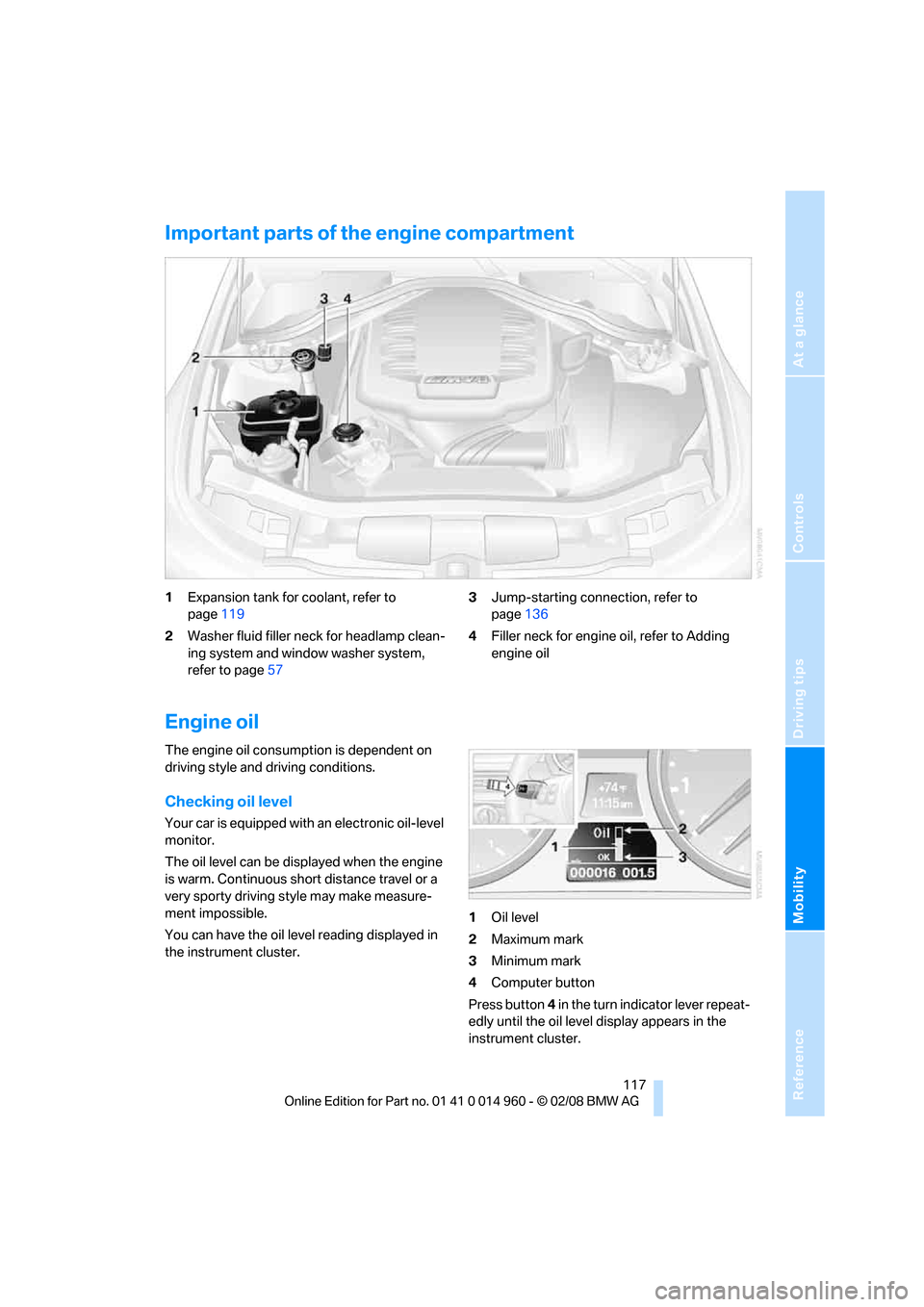
Reference
At a glance
Controls
Driving tips
Mobility
117
Important parts of the engine compartment
1Expansion tank for coolant, refer to
page119
2Washer fluid filler neck for headlamp clean-
ing system and window washer system,
refer to page573Jump-starting connection, refer to
page136
4Filler neck for engine oil, refer to Adding
engine oil
Engine oil
The engine oil consumption is dependent on
driving style and driving conditions.
Checking oil level
Your car is equipped with an electronic oil-level
monitor.
The oil level can be displayed when the engine
is warm. Continuous short distance travel or a
very sporty driving style may make measure-
ment impossible.
You can have the oil level reading displayed in
the instrument cluster.1Oil level
2Maximum mark
3Minimum mark
4Computer button
Press button 4 in the turn indicator lever repeat-
edly until the oil level display appears in the
instrument cluster.
Page 120 of 172
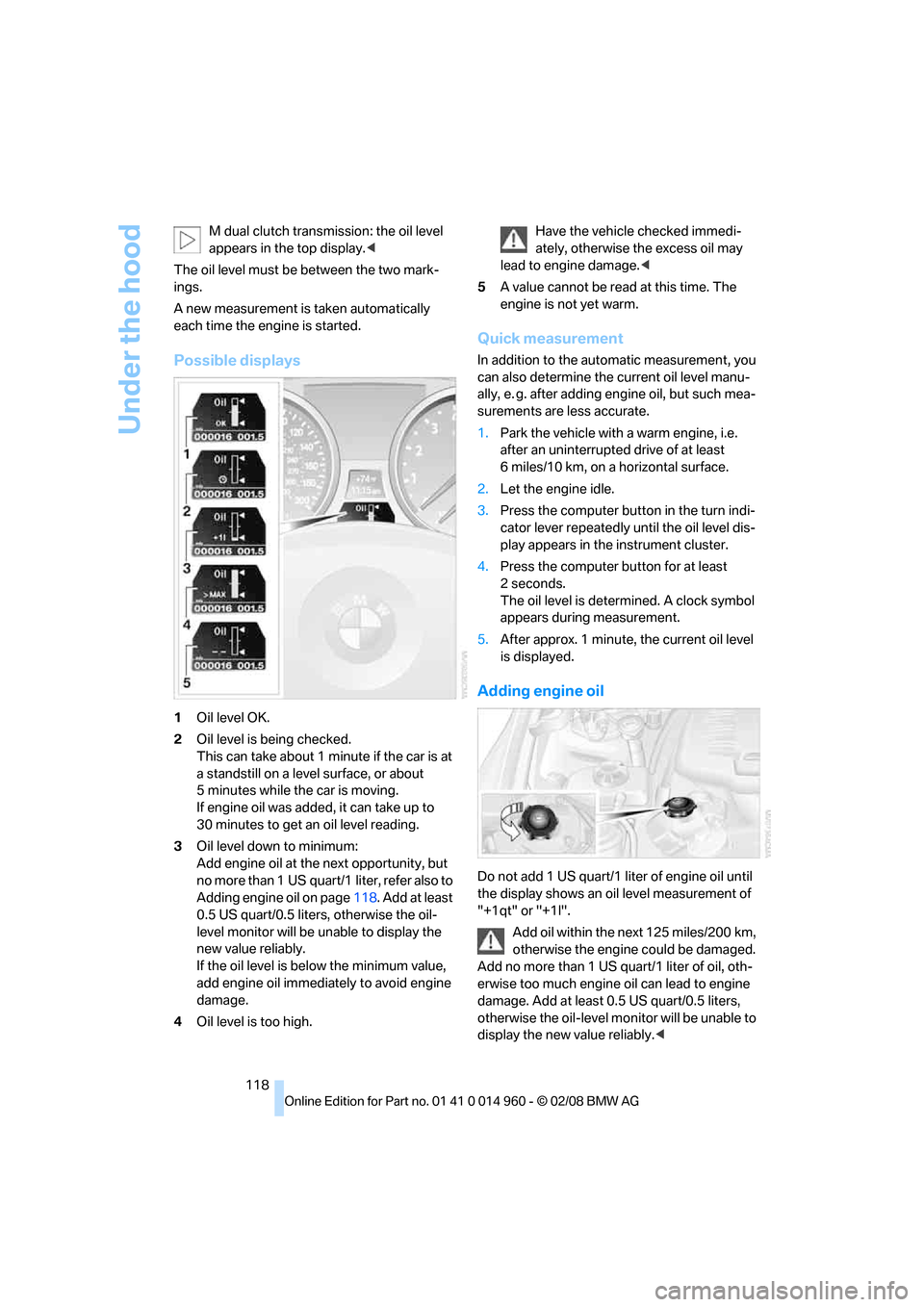
Under the hood
118 M dual clutch transmission: the oil level
appears in the top display.<
The oil level must be between the two mark-
ings.
A new measurement is taken automatically
each time the engine is started.
Possible displays
1Oil level OK.
2Oil level is being checked.
This can take about 1 minute if the car is at
a standstill on a level surface, or about
5 minutes while the car is moving.
If engine oil was added, it can take up to
30 minutes to get an oil level reading.
3Oil level down to minimum:
Add engine oil at the next opportunity, but
no more than 1 US quart/1 liter, refer also to
Adding engine oil on page118. Add at least
0.5 US quart/0.5 liters, otherwise the oil-
level monitor will be unable to display the
new value reliably.
If the oil level is below the minimum value,
add engine oil immediately to avoid engine
damage.
4Oil level is too high.Have the vehicle checked immedi-
ately, otherwise the excess oil may
lead to engine damage.<
5A value cannot be read at this time. The
engine is not yet warm.
Quick measurement
In addition to the automatic measurement, you
can also determine the current oil level manu-
ally, e. g. after adding engine oil, but such mea-
surements are less accurate.
1.Park the vehicle with a warm engine, i.e.
after an uninterrupted drive of at least
6 miles/10 km, on a horizontal surface.
2.Let the engine idle.
3.Press the computer button in the turn indi-
cator lever repeatedly until the oil level dis-
play appears in the instrument cluster.
4.Press the computer button for at least
2seconds.
The oil level is determined. A clock symbol
appears during measurement.
5.After approx. 1 minute, the current oil level
is displayed.
Adding engine oil
Do not add 1 US quart/1 liter of engine oil until
the display shows an oil level measurement of
"+1qt" or "+1l".
Add oil within the next 125 miles/200 km,
otherwise the engine could be damaged.
Add no more than 1 US quart/1 liter of oil, oth-
erwise too much engine oil can lead to engine
damage. Add at least 0.5 US quart/0.5 liters,
otherwise the oil-level monitor will be unable to
display the new value reliably.<
Page 121 of 172

Reference
At a glance
Controls
Driving tips
Mobility
119
Keep oils, greases, etc. out of the reach of
children and comply with the relevant
warnings on the containers. Otherwise, health
hazards may result.<
Oil change
Have oil changed only at your BMW center or at
a workshop that works according to BMW
repair procedures with correspondingly trained
personnel.
Specified engine oils
The quality of the engine oil selected has critical
significance for the operation and service life of
an engine. BMW continuously approves spe-
cific oils after confirming their suitability for use
in its vehicles with extensive testing.
Do not use oil additives as these may
cause engine damage.<
Your BMW center will be glad to answer
any questions regarding BMW High Per-
formance Synthetic Oil or approved synthetic
oils.<
You can also call BMW of North America at
1-800-831-1117 or visit the website
www.bmwusa.com to obtain this information.
Viscosity ratings
Viscosity is a measure of an oil's flow rating and
is categorized in SAE classes.
Approved oils belong to the 10W-60 SAE
class.<
Alternative oil types
If BMW High Performance Synthetic Oil is not
available, you can add small quantities of other
synthetic oils in between oil changes. Only use
oils with the following specifications:
>Viscosity:
preferred: SAE 10W-60;
alternative: SAE 10W-40, SAE 5W-50 or
SAE 10W-50
>Specification:
API SJ/CF, API SK/CF or higher
Low ambient temperatures
The oils used at BMW factories for your vehicle
type are suitable for virtually any ambient tem-
perature. However, if the vehicle is operated at
temperatures below –47/–206 for extended
periods, your BMW center will be glad to rec-
ommend an optimal oil.
Coolant
Do not add coolant to the cooling system
when the engine is hot. Escaping coolant
can cause burns.<
Coolant consists of half water and half additive.
Not all commercially available additives are suit-
able for your BMW. Ask your BMW center for
suitable additives.
Only use suitable additives, otherwise
engine damage may result. Because
additives are harmful to your health, it is impor-
tant to follow the instructions on the contain-
ers.<
Comply with the appropriate environ-
mental protection regulations when dis-
posing of coolant additives.<
Checking coolant level
1.Do not open the engine hood before the
engine has cooled down.
2.Turn the cap of the expansion tank a little
counterclockwise to allow any accumulated
pressure to escape, then continue turning
to open.
3.The coolant level is correct if it is between
the maximum and minimum marks in the
filler neck, refer also to the diagram next to
the filler neck.
Page 123 of 172

Reference
At a glance
Controls
Driving tips
Mobility
121
Maintenance
BMW Maintenance System
The BMW Maintenance System supports the
preservation of the traffic and operating safety
of your BMW. The objective is to optimize
efforts with respect to minimal vehicle mainte-
nance costs.
If and when you come to sell your BMW, a com-
prehensive record of servicing will prove a sig-
nificant benefit.
Condition Based Service CBS
Sensors and special algorithms take the differ-
ent driving conditions of your BMW into
account. Condition Based Service uses this to
determine the current and future service
requirements. By letting you define a service
and maintenance regimen that reflects your
own individual requirements, the system builds
the basis for trouble-free driving.
In the instrument cluster, you can have the
remaining times or distances for selected main-
tenance tasks and any legally prescribed dates
displayed, refer to page63:
>Engine oil
>Brake pads: separately for front and rear
>Brake fluid
>Vehicle check
>Legally mandated inspections depending
on local regulations
Service data in the remote control
Your vehicle continuously stores service-
requirement information in the remote control
while you are driving. Your BMW Service Advi-
sor can read out this data from the remote con-
trol unit, and propose an optimized mainte-
nance approach. Whenever you take your car in
for servicing you should therefore hand your
BMW Service Advisor the remote control unit
that you last used.
Make sure that the date in the instrument
cluster is always set correctly, refer to
page64; otherwise the effectiveness of Condi-
tion Based Service CBS is not assured.<
Service and Warranty Information
Booklet for US models and Warranty
and Service Guide Booklet for
Canadian models
Please consult your Service and Warranty Infor-
mation Booklet for US models and Warranty
and Service Guide Booklet for Canadian models
for additional information on service require-
ments.
BMW recommends that you have service
and repair operations performed at your
BMW center.
Take the time to ensure that these service pro-
cedures are confirmed by entries in your vehi-
cle's Service and Warranty Information Booklet
for US models and Warranty and Service Guide
Booklet for Canadian models. These entries
verify that your vehicle has received the speci-
fied regular maintenance.<
Page 125 of 172
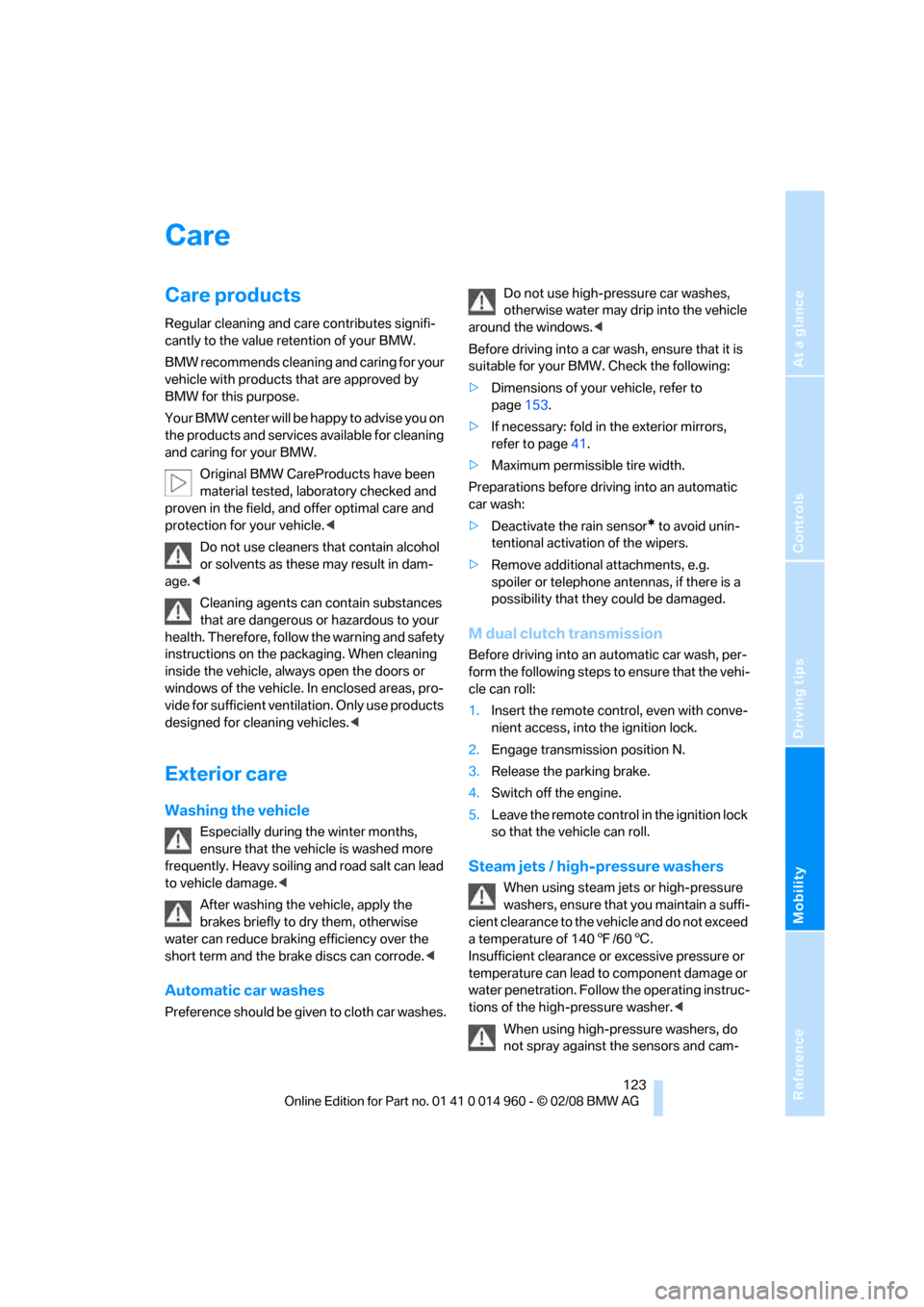
Reference
At a glance
Controls
Driving tips
Mobility
123
Care
Care products
Regular cleaning and care contributes signifi-
cantly to the value retention of your BMW.
BMW recommends cleaning and caring for your
vehicle with products that are approved by
BMW for this purpose.
Your BMW center will be happy to advise you on
the products and services available for cleaning
and caring for your BMW.
Original BMW CareProducts have been
material tested, laboratory checked and
proven in the field, and offer optimal care and
protection for your vehicle.<
Do not use cleaners that contain alcohol
or solvents as these may result in dam-
age.<
Cleaning agents can contain substances
that are dangerous or hazardous to your
health. Therefore, follow the warning and safety
instructions on the packaging. When cleaning
inside the vehicle, always open the doors or
windows of the vehicle. In enclosed areas, pro-
vide for sufficient ventilation. Only use products
designed for cleaning vehicles.<
Exterior care
Washing the vehicle
Especially during the winter months,
ensure that the vehicle is washed more
frequently. Heavy soiling and road salt can lead
to vehicle damage.<
After washing the vehicle, apply the
brakes briefly to dry them, otherwise
water can reduce braking efficiency over the
short term and the brake discs can corrode.<
Automatic car washes
Preference should be given to cloth car washes.Do not use high-pressure car washes,
otherwise water may drip into the vehicle
around the windows.<
Before driving into a car wash, ensure that it is
suitable for your BMW. Check the following:
>Dimensions of your vehicle, refer to
page153.
>If necessary: fold in the exterior mirrors,
refer to page41.
>Maximum permissible tire width.
Preparations before driving into an automatic
car wash:
>Deactivate the rain sensor
* to avoid unin-
tentional activation of the wipers.
>Remove additional attachments, e.g.
spoiler or telephone antennas, if there is a
possibility that they could be damaged.
M dual clutch transmission
Before driving into an automatic car wash, per-
form the following steps to ensure that the vehi-
cle can roll:
1.Insert the remote control, even with conve-
nient access, into the ignition lock.
2.Engage transmission position N.
3.Release the parking brake.
4.Switch off the engine.
5.Leave the remote control in the ignition lock
so that the vehicle can roll.
Steam jets / high-pressure washers
When using steam jets or high-pressure
washers, ensure that you maintain a suffi-
cient clearance to the vehicle and do not exceed
a temperature of 1407/606.
Insufficient clearance or excessive pressure or
temperature can lead to component damage or
water penetration. Follow the operating instruc-
tions of the high-pressure washer.<
When using high-pressure washers, do
not spray against the sensors and cam-
Page 150 of 172
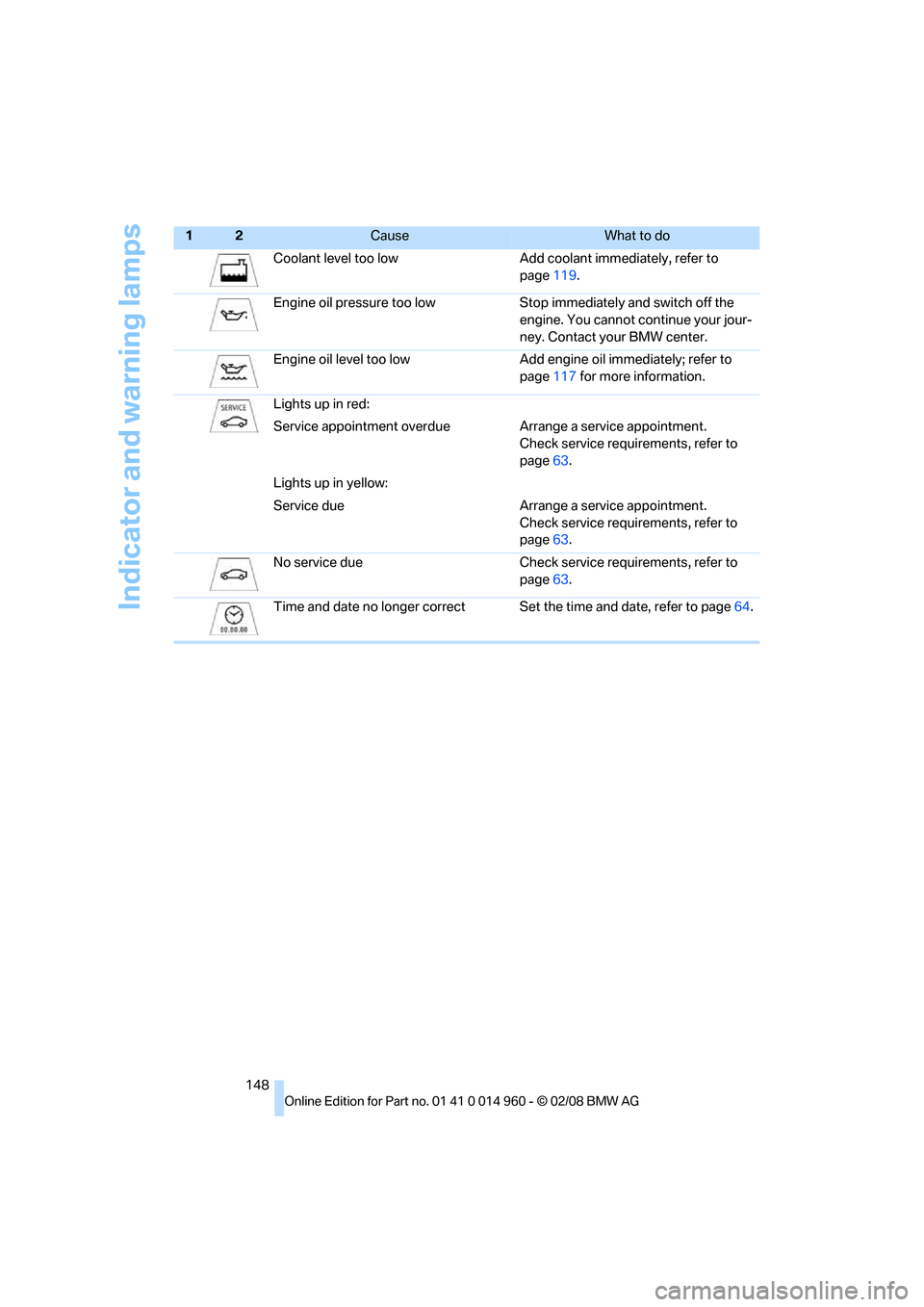
Indicator and warning lamps
148Coolant level too low Add coolant immediately, refer to
page119.
Engine oil pressure too low Stop immediately and switch off the
engine. You cannot continue your jour-
ney. Contact your BMW center.
Engine oil level too low Add engine oil immediately; refer to
page117 for more information.
Lights up in red:
Service appointment overdue Arrange a service appointment.
Check service requirements, refer to
page63.
Lights up in yellow:
Service due Arrange a service appointment.
Check service requirements, refer to
page63.
No service due Check service requirements, refer to
page63.
Time and date no longer correct Set the time and date, refer to page64.
12Cause What to do
Page 161 of 172
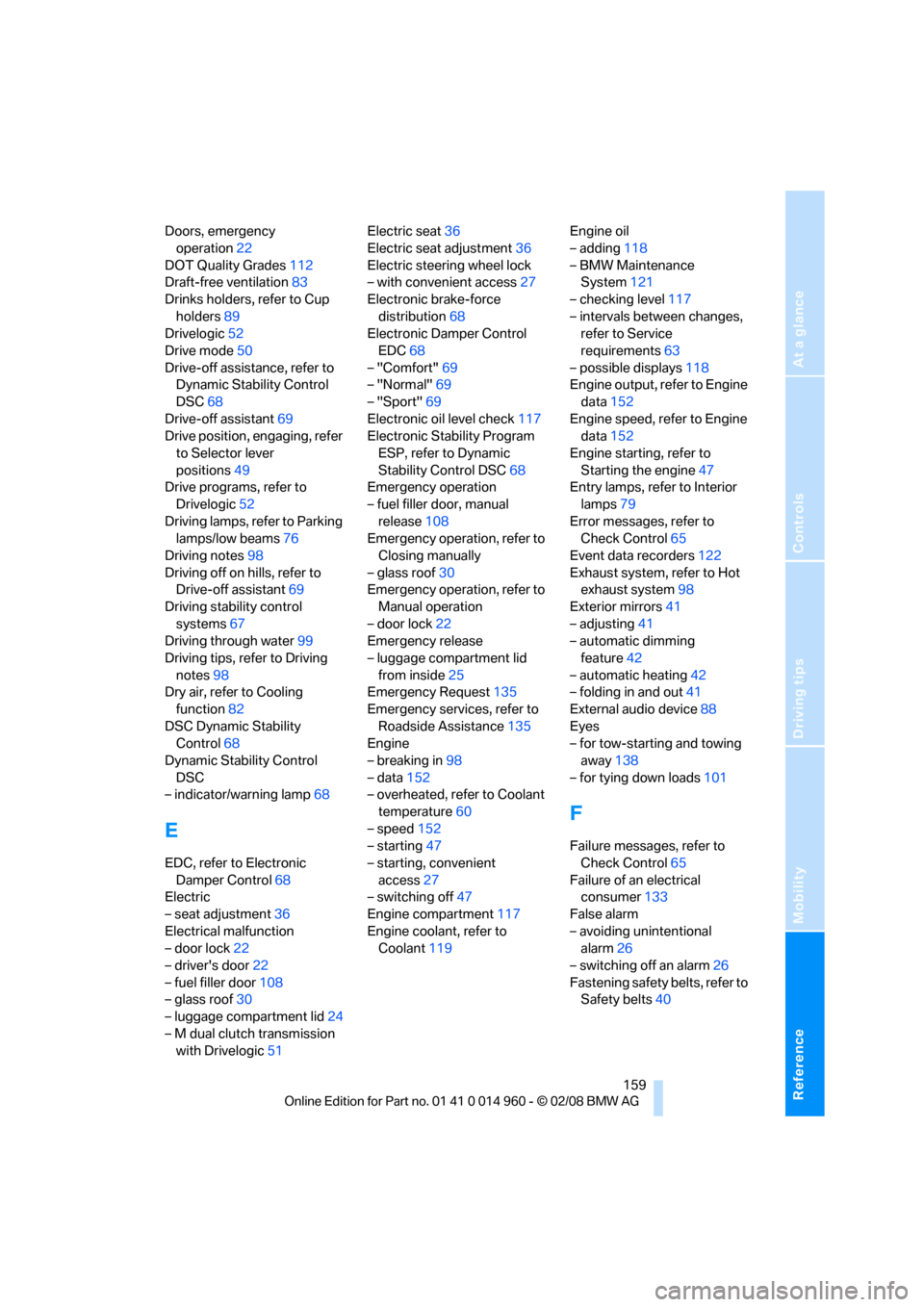
Reference
At a glance
Controls
Driving tips
Mobility
159
Doors, emergency
operation22
DOT Quality Grades112
Draft-free ventilation83
Drinks holders, refer to Cup
holders89
Drivelogic52
Drive mode50
Drive-off assistance, refer to
Dynamic Stability Control
DSC68
Drive-off assistant69
Drive position, engaging, refer
to Selector lever
positions49
Drive programs, refer to
Drivelogic52
Driving lamps, refer to Parking
lamps/low beams76
Driving notes98
Driving off on hills, refer to
Drive-off assistant69
Driving stability control
systems67
Driving through water99
Driving tips, refer to Driving
notes98
Dry air, refer to Cooling
function82
DSC Dynamic Stability
Control68
Dynamic Stability Control
DSC
– indicator/warning lamp68
E
EDC, refer to Electronic
Damper Control68
Electric
– seat adjustment36
Electrical malfunction
– door lock22
– driver's door22
– fuel filler door108
– glass roof30
– luggage compartment lid24
– M dual clutch transmission
with Drivelogic51Electric seat36
Electric seat adjustment36
Electric steering wheel lock
– with convenient access27
Electronic brake-force
distribution68
Electronic Damper Control
EDC68
– "Comfort"69
– "Normal"69
– "Sport"69
Electronic oil level check117
Electronic Stability Program
ESP, refer to Dynamic
Stability Control DSC68
Emergency operation
– fuel filler door, manual
release108
Emergency operation, refer to
Closing manually
– glass roof30
Emergency operation, refer to
Manual operation
– door lock22
Emergency release
– luggage compartment lid
from inside25
Emergency Request135
Emergency services, refer to
Roadside Assistance135
Engine
– breaking in98
– data152
– overheated, refer to Coolant
temperature60
– speed152
– starting47
– starting, convenient
access27
– switching off47
Engine compartment117
Engine coolant, refer to
Coolant119Engine oil
– adding118
– BMW Maintenance
System121
– checking level117
– intervals between changes,
refer to Service
requirements63
– possible displays118
Engine output, refer to Engine
data152
Engine speed, refer to Engine
data152
Engine starting, refer to
Starting the engine47
Entry lamps, refer to Interior
lamps79
Error messages, refer to
Check Control65
Event data recorders122
Exhaust system, refer to Hot
exhaust system98
Exterior mirrors41
– adjusting41
– automatic dimming
feature42
– automatic heating42
– folding in and out41
External audio device88
Eyes
– for tow-starting and towing
away138
– for tying down loads101
F
Failure messages, refer to
Check Control65
Failure of an electrical
consumer133
False alarm
– avoiding unintentional
alarm26
– switching off an alarm26
Fastening safety belts, refer to
Safety belts40
Page 162 of 172
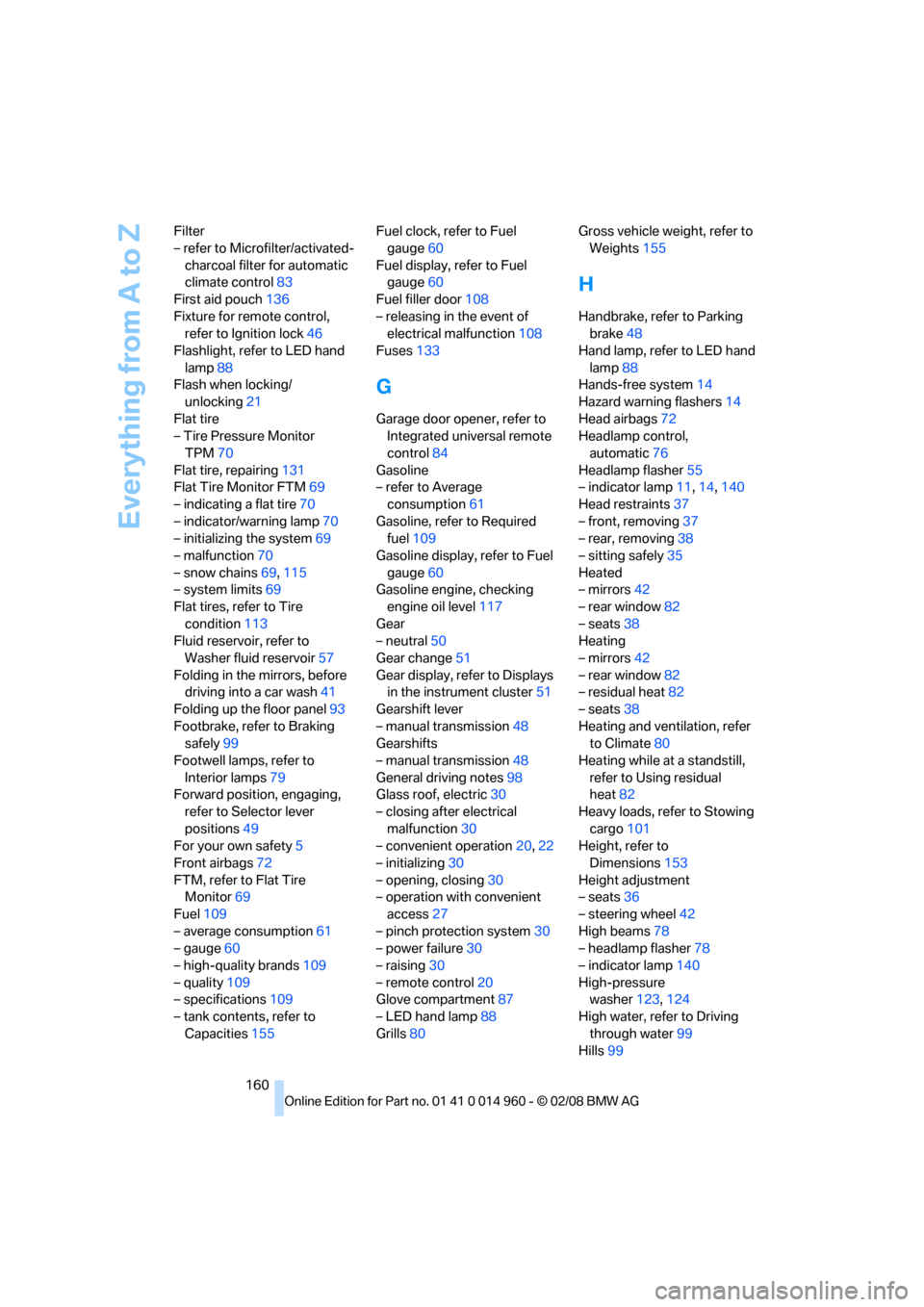
Everything from A to Z
160 Filter
– refer to Microfilter/activated-
charcoal filter for automatic
climate control83
First aid pouch136
Fixture for remote control,
refer to Ignition lock46
Flashlight, refer to LED hand
lamp88
Flash when locking/
unlocking21
Flat tire
– Tire Pressure Monitor
TPM70
Flat tire, repairing131
Flat Tire Monitor FTM69
– indicating a flat tire70
– indicator/warning lamp70
– initializing the system69
– malfunction70
– snow chains69,115
– system limits69
Flat tires, refer to Tire
condition113
Fluid reservoir, refer to
Washer fluid reservoir57
Folding in the mirrors, before
driving into a car wash41
Folding up the floor panel93
Footbrake, refer to Braking
safely99
Footwell lamps, refer to
Interior lamps79
Forward position, engaging,
refer to Selector lever
positions49
For your own safety5
Front airbags72
FTM, refer to Flat Tire
Monitor69
Fuel109
– average consumption61
– gauge60
– high-quality brands109
– quality109
– specifications109
– tank contents, refer to
Capacities155Fuel clock, refer to Fuel
gauge60
Fuel display, refer to Fuel
gauge60
Fuel filler door108
– releasing in the event of
electrical malfunction108
Fuses133
G
Garage door opener, refer to
Integrated universal remote
control84
Gasoline
– refer to Average
consumption61
Gasoline, refer to Required
fuel109
Gasoline display, refer to Fuel
gauge60
Gasoline engine, checking
engine oil level117
Gear
– neutral50
Gear change51
Gear display, refer to Displays
in the instrument cluster51
Gearshift lever
– manual transmission48
Gearshifts
– manual transmission48
General driving notes98
Glass roof, electric30
– closing after electrical
malfunction30
– convenient operation20,22
– initializing30
– opening, closing30
– operation with convenient
access27
– pinch protection system30
– power failure30
– raising30
– remote control20
Glove compartment87
– LED hand lamp88
Grills80Gross vehicle weight, refer to
Weights155
H
Handbrake, refer to Parking
brake48
Hand lamp, refer to LED hand
lamp88
Hands-free system14
Hazard warning flashers14
Head airbags72
Headlamp control,
automatic76
Headlamp flasher55
– indicator lamp11,14,140
Head restraints37
– front, removing37
– rear, removing38
– sitting safely35
Heated
– mirrors42
– rear window82
– seats38
Heating
– mirrors42
– rear window82
– residual heat82
– seats38
Heating and ventilation, refer
to Climate80
Heating while at a standstill,
refer to Using residual
heat82
Heavy loads, refer to Stowing
cargo101
Height, refer to
Dimensions153
Height adjustment
– seats36
– steering wheel42
High beams78
– headlamp flasher78
– indicator lamp140
High-pressure
washer123,124
High water, refer to Driving
through water99
Hills99